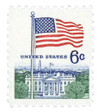
# 1338m - 1968 6c Flag and White House
U.S. #1338m Tagging Omitted
6¢ Flag and White House
Issue Date: January 24, 1968
City: Washington, DC
Printed By: Bureau of Engraving and Printing
Printing Method: Giori press
Perforations: 11
Color: Dark blue, red and green
This is the re-designed version of the flag stamp issued in 1963. It was the first to carry both the "Mail Early in the Day" and "Use Zip Code" slogans in the margins. Produced using various perforations, this stamp was also printed with an 8¢ denomination, and in 1969, it became the first multicolored coil.
Now you can own this stamp with rare tagging omitted. Did you know a stamp missing its phosphorescent tagging is considered by many to be similar to a missing color error? The good news is that unlike some error stamps, untagged error stamps are affordable.
What is Phosphorescent Tagging and Why is it Important?
Tagging of U.S. stamps was introduced in 1963 with airmail stamp #C64a. It helps the U.S. Post Office use automation to move the mail at a lower cost. A virtually invisible phosphorescent material is applied either to stamp ink or paper, or to stamps after printing. This “taggant” causes each one to glow in shades of green (red on older airmails) for a moment after exposure to short-wave ultraviolet (UV) light. The afterglow makes it possible for facing-canceling machines to locate the stamp on the mail piece, and properly position it for automated cancellation and sorting.
Some stamps have been printed with and without tagging intentionally, but when tagging is omitted by accident, we collectors are treated to a scarce modern color error. Our stamp experts examined thousands of stamps to find these just for you. Now you can easily give your error collection a boost or explore this fascinating new area of collecting. Quantities are limited, so order your untagged error stamp right away.
And find more tagging omitted stamps here.
U.S. #1338m Tagging Omitted
6¢ Flag and White House
Issue Date: January 24, 1968
City: Washington, DC
Printed By: Bureau of Engraving and Printing
Printing Method: Giori press
Perforations: 11
Color: Dark blue, red and green
This is the re-designed version of the flag stamp issued in 1963. It was the first to carry both the "Mail Early in the Day" and "Use Zip Code" slogans in the margins. Produced using various perforations, this stamp was also printed with an 8¢ denomination, and in 1969, it became the first multicolored coil.
Now you can own this stamp with rare tagging omitted. Did you know a stamp missing its phosphorescent tagging is considered by many to be similar to a missing color error? The good news is that unlike some error stamps, untagged error stamps are affordable.
What is Phosphorescent Tagging and Why is it Important?
Tagging of U.S. stamps was introduced in 1963 with airmail stamp #C64a. It helps the U.S. Post Office use automation to move the mail at a lower cost. A virtually invisible phosphorescent material is applied either to stamp ink or paper, or to stamps after printing. This “taggant” causes each one to glow in shades of green (red on older airmails) for a moment after exposure to short-wave ultraviolet (UV) light. The afterglow makes it possible for facing-canceling machines to locate the stamp on the mail piece, and properly position it for automated cancellation and sorting.
Some stamps have been printed with and without tagging intentionally, but when tagging is omitted by accident, we collectors are treated to a scarce modern color error. Our stamp experts examined thousands of stamps to find these just for you. Now you can easily give your error collection a boost or explore this fascinating new area of collecting. Quantities are limited, so order your untagged error stamp right away.
And find more tagging omitted stamps here.











